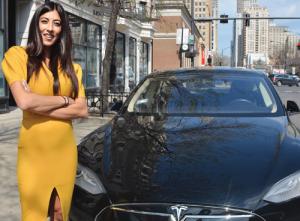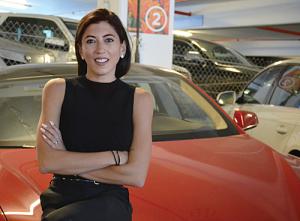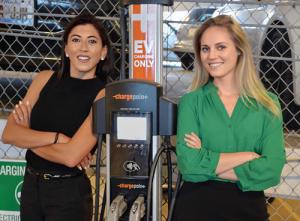Illinois Explores Electric Vehicles
Anastasia Palivos is Acting Commissioner at the Illinois Commerce Commission.
The global race toward a new energy economy is in full swing. Many Western European countries and even major U.S. economic competitors like China and India have committed to meeting substantial carbon reduction goals.

While the U.S. has been a leader in areas like energy efficiency for decades, to date, adoption of a federal carbon reduction policy has languished, leading states to proactively examine policies that prioritize clean energy jobs and investment.
Most recently, the Illinois Commerce Commission signaled interest in transportation electrification by hosting a Policy Session on April 4, 2018, to consider the nexus between electric vehicle adoption and grid stabilization.
The ICC organized the session following reports indicating that widespread EV adoption could bring Illinois up to forty-three billion in benefits by 2050 stemming from reduced utility bills, carbon pollution, and fuel and vehicle expenses.
Myriad solutions exist to addressing carbon reduction. For instance, integrating distributed energy resources, including solar, wind, hydropower, and biomass, into the electric grid has the potential to both reduce reliance on fossil fuels and supply the grid with clean energy.
 Palivos with Ritta Merza, Legal & Policy Advisor: Drivers seek control over their charging experience and will often choose convenience over economics, which could mean charging upon arriving home from work.
Palivos with Ritta Merza, Legal & Policy Advisor: Drivers seek control over their charging experience and will often choose convenience over economics, which could mean charging upon arriving home from work.
As battery storage technology advances and the cost of batteries decreases, the cost of EVs is also decreasing. EVs are becoming a viable alternative to internal combustion engine vehicles, and, with increased deployment, may have the ability to serve as practical DERs.
Indeed, EVs present a multifaceted solution given that, in addition to reducing greenhouse gas emissions, they also have the capacity to complement the grid and other forms of DERs by increasing electricity reliability and resiliency.
Currently, Illinois has between twelve thousand and fifteen thousand EVs on the road, with a projected eighty-one thousand by 2030, according to a recent study by the Illinois PIRG Education Fund and Frontier Group.
With an increase in EV penetration, however, uncoordinated charging can lead to additional power losses and voltage variations that overload the power grid. Thus, policies and standards will be necessary to achieve optimal EV charging because coordinated charging can improve frequency regulation, smooth out the generation intermittency from DERs, and increase efficient electricity usage.
 Commissioner Palivos: Currently, the large majority of EV charging takes place at home, with a small portion done at work.
Commissioner Palivos: Currently, the large majority of EV charging takes place at home, with a small portion done at work.
The Commission's Policy Session in Chicago featured experts from around the country who discussed the benefits and impacts of EVs, the legal and policy framework necessary for robust EV deployment, and best practices and trends for successful rate structuring and grid integration.
The Commission was especially interested in learning about successful EV programs in other states and recommended next steps for Illinois to consider in laying the proper foundation for EV adoption.
Panel Discussion
Panelists agreed that the most pressing anxiety expressed by both utilities and the charging industry is unorganized EV charging - meaning drivers will not charge at optimal times, creating prolonged and more expensive peak demand hours.
This is because drivers seek control over their charging experience and will often choose convenience over economics, which could mean charging upon arriving home from work when energy prices are often highest.
 Palivos with Emily Brumit, Legal & Policy Advisor: Most industry experts agree that incorporating EV-friendly language into building codes will reduce costs of EV related construction and renovation in the future.
Palivos with Emily Brumit, Legal & Policy Advisor: Most industry experts agree that incorporating EV-friendly language into building codes will reduce costs of EV related construction and renovation in the future.
According to the Smart Electric Power Alliance, "The challenge for utilities is to find a way to distribute these charging events across the full span of off-peak hours, or even better, to time vehicle charging for periods of high renewable energy production - midday for solar or night-time for wind."
Solutions for managed charging are therefore critical given the growing concern that EV-related utility rate increases could impact those who are unable to participate in EV programs or realize the long-term cost benefits.
Unfortunately, "Many of the communities that stand to benefit the most from electric vehicles don't have access to them," said Christie Hicks of the Environmental Defense Fund. Electric utilities are hopeful, however, that financial incentives and accurate price signals for off-peak charging will encourage drivers to support their goals of balancing peak demand.
If utilities incentivize smart charging, an increased number of EVs could improve grid reliability and resiliency and could reduce overall electricity prices for EV owners. Commonwealth Edison's Jane Park attributed recent increased EV deployment to, "A confluence of technology advancements and national and international policy."
She explained that, "States with the highest EV adoption offer a portfolio of purchase incentives, dynamic pricing programs, infrastructure plans, and accessibility for low-income communities."
According to panelists, critical to the conversation is the knowledge gap. In order for customers to realize the full array of economic benefits available as a result of EVs, leading to widespread adoption, they must be equipped with the tools necessary for a fundamental understanding of how the grid functions or how to read their electric utility bill.
How else, panelists urged, can customers respond to the various price signals necessary for change?
Panelists also agreed that the high up-front cost of EV ownership is a major barrier for the majority of drivers. Auto manufacturers predict that EVs are set to reach cost parity with internal combustion engine vehicles in as little as seven years.
Senior Assistant Attorney General Susan Satter with the Illinois Office of the Attorney General pointed out that current EV owners are considered "early adopters" who earn well above the national average income, and likely do not require financial incentives to purchase or operate EVs.
Citizens Utility Board stressed that, "Using a combination of time-based rates, smart charging, financial incentives and other innovative applications, EV loads should be managed in the interest of all electricity customers." Incentives for early adopters should not place a burden on low-income utility customers or those choosing not to own an EV.
According to Elizabeth McErlean, an energy attorney with McGuireWoods, the legal and regulatory component of EV integration is uncharted territory in Illinois. Only about one percent of Illinoisans choose electric vehicles and thus the state's EV regulations are relatively undeveloped.
McErlean noted that EV charging stations are currently unregulated, unlike public utilities, and in 2012, the Illinois General Assembly exempted charging station owners from the definition of "utility," seemingly to encourage private investment in the development of EV charging stations.
According to McErlean, this will leave the industry ample room to grow and experiment with best practices and intelligent rate design. While utilities prepare for a possible exponential increase in EV deployment, utility panelists do not anticipate legal changes anytime soon, and agreed that now is not the time to place strict regulations on EV owners or the charging industry.
The session's panelists agreed as to the overarching concerns with and the positive impacts of EVs, and also agreed that getting drivers into EVs is currently the highest priority. In the meantime, there are steps that utilities and regulators can take to ensure that when drivers are ready to make the switch, the grid can sustain and balance energy demand.
ICC Role
As an acting ICC Commissioner, I encourage my fellow Commissioners to consider initiating a Notice of Inquiry (NOI), a procedural method under the Commission's rules allowing the agency to gather information about suitable EV policies on matters such as rate design, charging infrastructure, and the associated responsibilities for utilities.
While it is the primary responsibility to ensure grid reliability and quality of service, the regulators' role as it concerns EVs may vary from state-to-state. By requesting that stakeholders submit comments on best practices for EV implementation, the ICC can better evaluate possibilities for next steps and decide whether a rulemaking is appropriate.
Furthermore, the process would allow the ICC to gather information about what has worked in other states, including whether pilot programs could increase customer awareness.
As EV deployment is currently relatively low, Illinois has the opportunity to think creatively and learn from EV programs across the nation to determine what may benefit drivers and electricity customers at home.
The remainder of this article discusses the options available to the ICC for information gathering and the various questions regulators, utilities, and consumers alike need answered before Illinois can confidently explore a successful EV program.
Rate Design
In its NOI, the ICC could seek information about time-varying rates, such as time-of-use rates versus hourly use rates, and the best option for maximum EV penetration in the state. One form of time-varying rate, known as time-of-use (TOU) charging or TOU pricing, provides information about predictable on-peak and off-peak periods and encourages consumers to track overall electricity use throughout the day.
TOU pricing can be structured to reflect the cost of energy, system capacity, and emissions levels in a given region. System-wide TOU pricing could help align grid needs throughout the day, and drivers could receive price signals to better understand optimal times to charge their EVs.
This could allow for lower charging costs to consumers, and help drivers understand how their charging habits contribute to the overall energy management of other integrated DERs, like solar and wind.
Currently in Illinois, utility customers can charge their vehicle on a fixed rate option, like a TOU rate, or an hourly rate, like Commonwealth Edison's (ComEd) Residential Real-Time Pricing (RRTP), or Ameren Illinois' equivalent Power Smart Pricing program.
Under both programs, prices are based on the actual hourly market price of electricity and customers are notified when real-time prices are high, or expected to be high, so they can respond accordingly. Occasionally, utilities can purchase energy at prices below zero, allowing EV owners on hourly pricing to profit by charging their cars.
In order to reach optimal EV penetration in the state, the ICC could consider whether it is advisable to require EVs to participate in a coalesced rate design or in a demand response program. Initiating an NOI could jumpstart the process of gathering information on various options for rate designs to determine which pricing structure might be best for the state overall.
Types of Charging Stations
To date, there is no network of refueling stations akin to the large number of gas stations in the U.S., and optimal locations for charging infrastructure are constantly under investigation. Currently, the large majority of EV charging takes place at home, with a small portion done at work.
According to the Idaho National Laboratory Study of EV infrastructure, developing more Direct Current Fast Charging (DCFC) locations is a key to increasing EV adoption. Through an NOI, stakeholders could have the opportunity to share their expertise on where charging locations should be further developed.
They could also share on what types of charging, such as DCFC or slow charging, should be available at various locations, whether busy corridors around the state, or densely populated areas like downtown Chicago.
According to the Chicago Transit Authority, a mix of fast charging and slow charging is likely the answer to meet fluctuating driver needs. However, with the deployment of more DCFC infrastructure, regulators and utilities will need to consider the implications of increased electricity demand on the grid.
While the majority of EV charging occurs at home, expanding access to charging at the work place could help balance grid load throughout the day. Charging companies such as ChargePoint offer solutions for workplaces, allowing companies to provide on-site EV charging as an employee benefit.
According to ChargePoint, "One in four of the companies featured in the Fortune '100 Best Companies to Work For' during the last five years uses ChargePoint to attract and retain talent, achieve sustainability goals, and establish its brand as a leader in corporate social responsibility."
By providing employees the opportunity to charge their EVs throughout the work day, grid load could positively fluctuate, and drivers could receive price signals prompting them to charge during those mid-day, off-peak hours. This strategy may not benefit the grid in all regions, especially where solar is a prevalent DER, and may be seasonal in others.
Responsibility for EV Infrastructure Deployment
Although utilities are directly responsible for distributed technologies like renewable energy, energy efficiencies, energy storage and demand, no state has mandated that utilities be directly responsible for EVs or EV infrastructure deployment.
An NOI could further investigate why EVs have garnered unique treatment as a DER compared to other demand response technologies. Utilities and other stakeholders could provide comment on whether it could be beneficial to change this management structure.
If not beneficial, they could comment on how Illinois could justify the necessary buildout of new charging infrastructure, and what type of tariffs could work for privately-owned infrastructure.
In questioning responsibility for infrastructure development, we must also research and devise appropriate funding mechanisms. Currently, utilities nationally operate two and half billion dollars of EV infrastructure programs, but that funding source just scratches the surface of availability. Whether it comes from private capital, taxpayer money or public sources, we must find fair and equitable means to responsibly fund EV infrastructure.
Outside of an ICC NOI or Proposed Rulemaking, there are creative options that utilities and industry stakeholders can model in Illinois to move the needle on EVs. While outside the ICC's authority, developing EV-friendly building code regulations could be another asset to increased EV market penetration.
In 2016, the City and County of Denver echoed many municipalities across the country and took a preemptive step toward creating a more reliable and resilient electric grid by adopting an "EV Ready" building code.
EV Ready codes include planning for sufficient capacity in the electrical panel for a Level 2 charging station, and wiring from the electrical panel to the garage or parking lot. Denver's new code amendment requires that new single-family homes and duplexes built in the city have electrical wiring to support electric vehicle plugs in garages.
The Denver Planning Department's proposed changes were inspired by the 2015 update to the International Code Council's suggested rules, and other cities and municipalities including Boulder County, Vancouver, Salt Lake City, and various cities in California.
Some of those cities have also adopted EV-friendly building codes for multi-family residential developments. Relying on the adage, "build it and they will come" presents a problem for utilities and consumers, who are left wondering when the financial benefits will justify the upfront infrastructure cost. However, most industry experts agree that incorporating EV-friendly language into building codes will reduce costs of EV related construction and renovation in the future.
Pilot Programs in Minnesota and California
EV pilot programs have made leaps and bounds since they began in the 1990s, taking into account carbon reduction goals and the emergence of new DER technology. If and when Illinois utilities are able to move forward with an EV pilot program, they could look to states like Minnesota and California for direction.
To increase public interest in EVs, the Minnesota Public Utilities Commission approved Xcel Energy's electric vehicle pilot program in early April 2018. The utility's program includes a "smart charger" that doesn't require customers to install a second electrical meter, which can be costly.
The charger is a two hundred forty-volt level two charger, instead of the one hundred twenty-volt level one charger most electric cars have. The level two charger can provide up to six times the charge of the level one, which will hopefully move to quell range anxiety often associated with EVs.
Xcel's new pilot also expects to curb sticker shock to customers interested in purchasing an EV. In 2015, Excel adopted a forty percent discount rate for its EV owners, but other related expenses, such as purchasing a second electrical meter, served as a deterrent.
Customers were required to purchase a second meter and pay for installation cost, which can range from two hundred to two thousand dollars. The new pilot program is limited to only a hundred customers, and Xcel is hopeful that the inclusion of a smart charger will persuade drivers to participate.
Even in California, the country's largest EV market, charging infrastructure remains a barrier to entry. California is currently piloting various charging programs where infrastructure may be owned by a utility or a third party; and there are various incentives, from variable pricing programs to ratepayer funding to rebates.
Following years of negotiation with the California Public Utilities Commission, in January 2018, the state launched the largest utility-sponsored EV charging pilot program in the nation. Pacific Gas & Electric's pilot program includes seventy-five hundred level two chargers and a budget of a hundred and thirty million.
PG&E will fund all infrastructure costs, "From the transformer to the parking space," according to spokesperson Ari Vanrenen. Utility-sponsored pilot programs might not be the best option for Illinois.
Industry experts, including the Electric Vehicle Charging Association, counter that allowing site hosts, or privately-owned charging companies, to determine rates and manage charging will foster more innovation and competition.
Each state is unique in its ability to offer electricity and renewable technology services based on consumer needs and behavior, available infrastructure, budget, and even weather patterns, on which DERs often rely.
Balancing consumer needs while ensuring grid reliability and quality of service is the primary responsibility of state regulators. While the scope of these responsibilities varies by state, the information gathering process remains the most important aspect of regulatory decision-making.
Conclusion
As grid reliability becomes a more pressing concern around the globe, with many countries and even communities in the U.S. still experiencing rolling blackouts, especially after inclement weather events, investigating ways to create a more integrated, functional and reliable grid is tantamount to meeting carbon reduction goals.
EVs have the potential to serve as a dependable DER, create a healthier environment and more robust economy, all while promoting behavior that leads to a more environmentally conscious and informed consumer.
As the ICC learned from panelists during its April 4 Policy Session, getting drivers into the seat of an EV is the biggest priority, but the type of infrastructure to build, where to build it, and how to fund it, remain largely unknown pieces of this puzzle.
While EV charging pricing structures do exist, the question remains which design is the best option for Illinois when considering increased market penetration of other DERs such as wind and solar.
In just twelve years, Illinois expects EV deployment to increase by six times the amount of EVs on the road today. The ICC is well-suited to investigate major EV barriers and best practices for achieving this goal by gathering information from industry experts and analyzing effective pilot programs in other states.
Illinois has moved into the top tier of state renewable energy goals, and it is time that EVs join the ranks of wind and solar as DERs. EVs are our future, and as regulators, it is incumbent on us to stay ahead of the curve.




